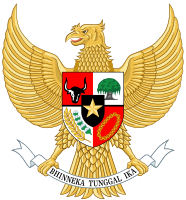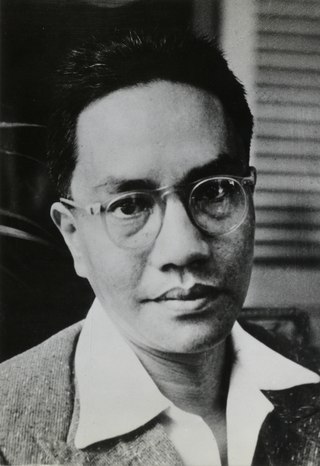
Amir Sjarifuddin Harahap was an Indonesian politician and journalist who served as the second prime minister of Indonesia from 1947 until 1948. A major leader of the left wing during the Indonesian National Revolution, he previously served as Minister of Information from 1945 until 1946 and Minister of Defense from 1945 until 1948. Amir was born into the Sumatran aristocracy and was educated at Leiden University. At Leiden, he became a member of the board of the Gymnasium student association in Haarlem and was involved in the Batak student organization Jong Batak. He returned to Indonesia due to family troubles but continued his education at the Rechts Hogeschool in Batavia.
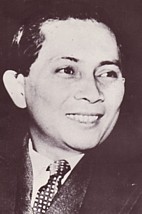
The position of Prime Minister of Indonesia existed from 1945 until 1966. During this period, the prime minister was in charge of the Cabinet of Indonesia, one of the three branches of government along with the People's Representative Council and the president. Following his 1959 decree, President Sukarno assumed the role and powers of prime minister until his resignation in 1966.

The Council of Indonesian Muslim Associations Party, better known as the Masyumi Party, was a major Islamic political party in Indonesia during the Liberal Democracy Era in Indonesia. It was banned in 1960 by President Sukarno for supporting the PRRI rebellion.

The First Sjahrir Cabinet was the second Indonesian cabinet, named after the prime minister. It served from November 1945 to March 1946.

The Third Sjahrir Cabinet was the fourth Indonesian cabinet. It served from October 1946 to July 1947, when it fell due to disagreements related to the implementation of the Linggadjati Agreement and subsequent negotiations with the Dutch.

The First Amir Sjarifuddin Cabinet was the fifth Indonesian cabinet and was in office from 3 July to 11 November 1947.

The First Hatta Cabinet was Indonesia's seventh cabinet. It was formed by Vice President Mohammad Hatta, who was instructed to do so by President Sukarno on 23 January 1948, the same day the previous cabinet was declared dissolved. Following the second Dutch military aggression, when the republican capital of Yogyakarta was seized and most of the cabinet arrested, much of the cabinet was captured and sent into exile, although it was not formally disbanded. After the political leadership returned effective 13 July 1949 the cabinet continued its mandate until it was reshuffled on 4 August.

The Second Hatta Cabinet was Indonesia's ninth cabinet. It was formed after the Indonesian leadership, which had been imprisoned by Dutch forces, returned to the capital, Yogyakarta. It served from 4 August to 20 December 1949.

Soekiman Wirjosandjojo was an Indonesian politician and physician who served as prime minister of Indonesia from 1951 until 1952. Additionally, Soekiman served as the first president of the Masyumi Party from 1945 to 1951.

The Susanto Cabinet was the first cabinet of the Republic of Indonesia while it was one of 16 states in the United States of Indonesia. It served from 20 December 1949 until 21 January 1950, when a permanent cabinet under the leadership of Prime Minister Abdul Halim was appointed.

The Halim Cabinet was the second and final cabinet of the Republic of Indonesia while it was one of 16 states in the United States of Indonesia. It served from 21 January until 15 August 1950, when the United States of Indonesia was dissolved and Indonesia once again became a unitary state.

Indonesian Islamic Union Party was an Islamic political party in Indonesia before and after independence. In 1973 it was merged into the United Development Party.
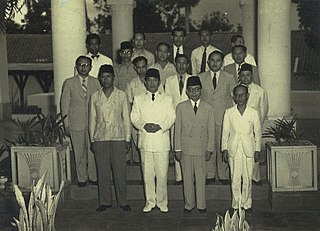
The Soekiman Cabinet, also known as the Sukiman-Suwirjo Cabinet, was an Indonesian cabinet that served from 27 April 1951 until it fell on 23 February 1952 following revelations that it had signed a mutual security agreement with the United States, and was dissolved on 3 April 1952.

The Wilopo Cabinet, also known as the Wilopo-Prawoto Cabinet, was an Indonesian cabinet that served from 3 April 1952 until 30 July 1953.

The First Ali Sastroamidjojo Cabinet was an Indonesian cabinet named after the prime minister, and also known as 'Kabinet IV', that served from 30 July 1953 until 12 August 1955.

The Burhanuddin Harahap Cabinet was an Indonesian cabinet, named after the prime minister, that served from 12 August 1955 until 24 March 1956.

The Second Ali Sastroamidjojo Cabinet, also known as the Ali-Roem-Idham Cabinet was an Indonesian cabinet that served from 24 March 1956 until 9 April 1957.

The Djuanda Cabinet, also known as the Working Cabinet, was an Indonesian cabinet that served from 9 April 1957 until 10 July 1959, when it was dissolved by a decree from President Sukarno.

Major general TNI (Tit.) dr. Adnan Kapau Gani or commonly abbreviated as A.K. Gani was an Indonesian doctor, politician, actor and military figure. He served as Deputy Prime Minister in the Cabinet of Amir Sjarifuddin I and the Cabinet of Amir Sjarifuddin II.
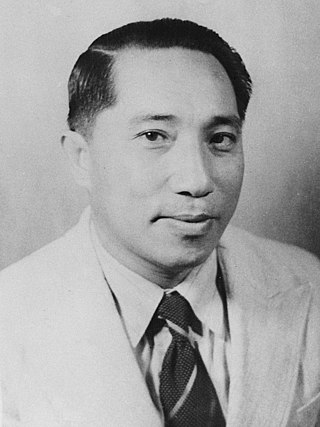
Herling Laoh was an Indonesian bureaucrat and engineer. A member of the Indonesian National Party (PNI), Laoh served as minister of public works (1947–1950) and minister of transportation (1949–1950). Born to a goldsmith and his wife in present-day North Sulawesi, he studied civil engineering at the Technische Hoogeschool te Bandoeng (THB). After graduating in 1928, he worked as an engineer in various construction projects. Following the Proclamation of Indonesian Independence in 1945, he joined the PNI and served as a minister in several cabinets. He was later involved in PRRI/Permesta rebellion, becoming a state minister in the rebel government.
